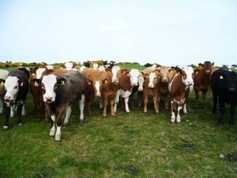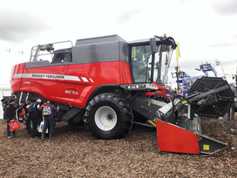Like all farms, the slow spring growth has increased feed costs considerably on the Kilkenny farm and only for the increase in milk price it would be a very serious cash deficit situation.
Revised milk sales after completing the first three months of the year show the farm will produce about €590,000 of milk sales in 2013, all going to plan. This is up €100,000 since the first projections were made in early January. Predicted base milk price for the year has been lifted to 35 c/litre.
Unlike some farmers, the Kilkenny farm won’t get all of the high milk price benefit this year as 20% of our output is locked into year one and two of the Glanbia fixed milk price scheme. We decided not to fix any more milk this year.
Also remember that a one cent per litre change in price will reduce or improve sales by almost €15,000. This is important when we take into account the bottom line in terms of cash is showing a surplus of only €24,000 after all costs have been paid.
The first quarter budget review also shows livestock sales are reduced from €87,200 to €65,446, reflecting lower calf and cull cow sales. Some 22 in calf cull cows were wintered, have now calved and are dried off and will be sold over the coming weeks.
They were worth around €300 each in November and could average €700 each if sold over coming weeks.
They will and still are contributing to higher feed costs but they have left a calf, some milk and probably at best will be break even in terms of return compared with selling last November.
The cost of dairy feed is up from €31,200 to €52,141. To date, the milking herd has been fed about 430kg of meal per cow. Extra forage had to be purchased for late March and April feeding and more will have to be purchased for next winter, so forage purchases will rise from the €15,000 predicted in January to at least close to €40,000, depending on what forage is purchased and at what cost.
All will depend on growth over the coming weeks and what can be conserved on farm. At this stage, 20 hectares have been closed and fertilised for first cut and smaller second cut (16.5ha) is planned. Using conservative estimates for yield, taking into account surplus bales etc, we will still be short about 100 tons of dry matter, so we have to plan for this and over coming weeks options will be assessed.
The stocking rate will be set at 3.5 cows/hectare for the next eight weeks, so there is a chance we will get surplus bales from the grazing block depending on growth rates.
The other item worth mentioning in terms of cost increases is that farm roadways had to be improved significantly as a large number of cows and freshly calved heifers had lameness issues since they started grazing after calving.
Roadways are a key part of the grazing game and when you have cows walking long distances, once they calve, as is the case in large scale dairy operations, you need a good surface. We topped off the limestone base we had on the farm with slig from Killenuale quarries at a cost of about €8.50 per metre delivered, laid and rolled. We covered about 2.1 kilometres of roadway at a total cost of just over €18,000.
To finish off the message on costs and sales – the net cash position is that we will generate total sales of over €660,000, but total costs are expected to finish close to €640,000, so a surplus of €20,000 is expected. This could easily be eroded depending on milk price and forage purchase after paying all interest, principal, and costs of production. Remember, the bigger you are, the quicker you can fall and only for the milk price uplift this year, we would be in a serious net cash deficit.
Current management
There are 325 cows milking. There is about 150kg of grass per cow on the farm and it is all excellent green leafy grass with growth rates averaging 47kg per day for the last week.
Fertility seems to be going well. Bulling started on the cows and maiden heifers the same day (24 April). In the maiden heifer bunch at the contract rearing farm, 77 from 94 heifers were picked up in heat in the first 14 days of breeding, so a decision was taken to continue picking up heats naturally and not bother with any injection.
Three Jersey stock bulls arrived on the farm this week and they will run with the maiden heifers to pick up the repeats. We are using all sexed semen on the maiden heifers. As described previously, last year we had to hire in help, costing €1,500 to manage with the breeding of the maiden heifers, but this year the contract rearers are picking out the heifers in heat and the technician serves them once a day.
Michael and Tom are picking up and serving on average about 12 cows per day from the milking herd. If this continues, it will mean close to 90% submission rate in the first three weeks. About 70 cows that were not picked up in heat before start of breeding were scanned in the first week of breeding and eight cows were washed out and the rest left alone to come in heat naturally.
OAD herd
There are about 30 cows (9%) in a second herd that has mostly lame cows and mastitis cows. They are milked once a day and have really improved in body condition score since they went on once a day milking.
There were about 50 cows in this once a day herd during the slow growth, mainly lame cows but regular hoof paring to cure the drops in most cows, foot bathing and roadway improvements have significantly improved the lameness situation.
SCC update
Using milk recording results and the poor man’s cluster flushing system, which is pre and post spraying, have both contributed to keeping a lid on somatic cell count.
This year, Michael and Tom started teat spraying before clusters are attached to limit cross infection from cow to cow and they are also post spraying once clusters come off. March SCC averaged less than 150,000 cells/ml and April averaged just slightly over 150,000 cells/ml. Milk recording results are invaluable in identifying repeat offenders and are used with individual cow records to take action like drying off infected quarters.
KEY POINTS
Meal feeding and forage purchase will be up significantly on January estimates but milk price is also up significantly.
Grass supply improved significantly since mid April but the herd continue to get 3kg of meal per cow per day
A small first cut is planned (20 from 113 hectares) but a second cut will be targeted (16/113 hectares). This will leave the farm short 100 to 150 tons of winter feed dry matter that will have to be purchased as either: grass silage, wholecrop silage, grain and straw, hay or fodder beet.
The herd are milking on average approx 24 litres at 3.50% protein and 3.74% fat (1.7kg MS) and 140,000 SCC. Milk supply for this farm for 2013 is approx 85,000 litres ahead of 2012 due to the earlier calving date and extra purchased feed.
KEY POINTS
Meal feeding and forage purchase will be up significantly on January estimates but milk price is also up significantly.
Grass supply improved significantly since mid April but the herd continue to get 3kg of meal per cow per day
A small first cut is planned (20 from 113 hectares) but a second cut will be targeted (16/113 hectares). This will leave the farm short 100 to 150 tons of winter feed dry matter that will have to be purchased as either: grass silage, wholecrop silage, grain and straw, hay or fodder beet.






 This is a subscriber-only article
This is a subscriber-only article











SHARING OPTIONS: